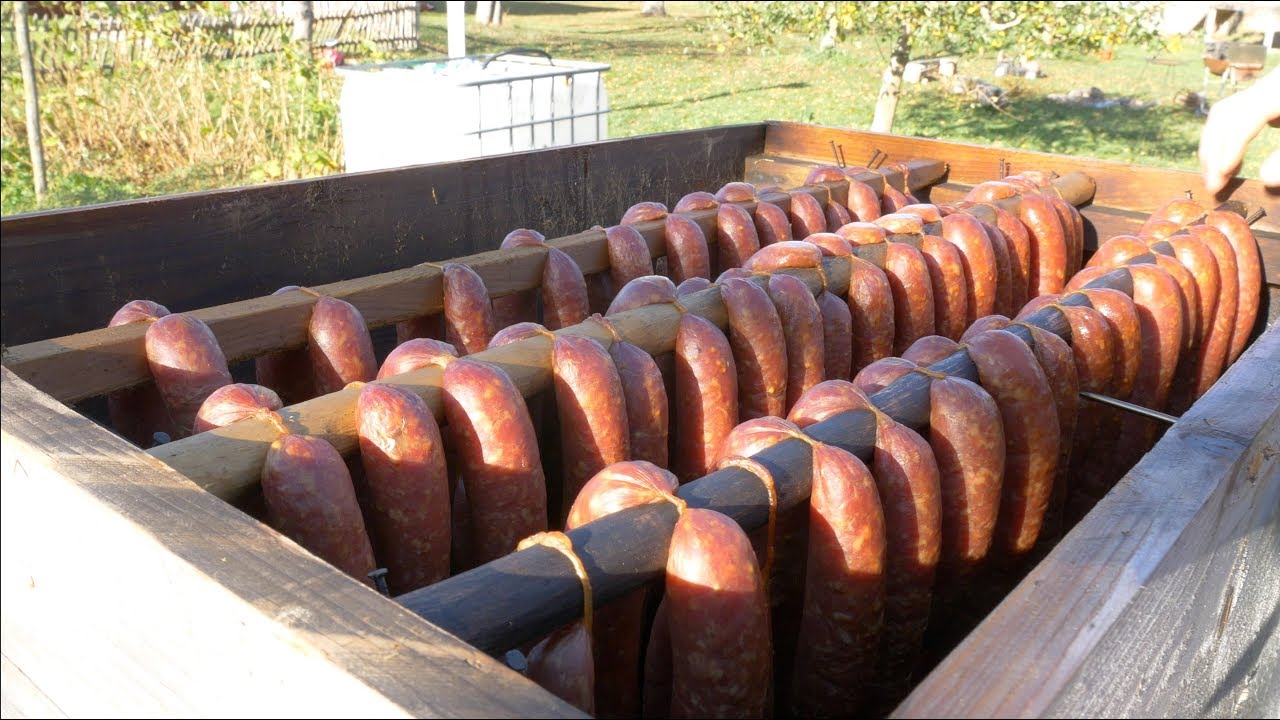Ever wondered how your favorite sausages are made? From the rich, savory flavors to the satisfying snap when you bite in, sausage making is both an art and a science. Whether it’s bratwurst, chorizo, or Italian sausage, the process involves a blend of meat, spices, and sometimes, a little bit of magic. If you’re curious about how these delicious links come to life, you’re in the right place! Plus, stick around to discover where you can watch this fascinating process unfold on Dailymotion.
History of Sausage Production

The history of sausage production is as rich and varied as the sausages themselves. Believe it or not, sausages have been around for thousands of years! Here’s a brief journey through time:
- Ancient Origins: The earliest known references to sausage date back to ancient Mesopotamia around 3000 BC. It’s said that the Sumerians made sausages from finely chopped meat, mixed with grains and spices.
- Classical Antiquity: The Greeks and Romans also embraced sausage-making. In fact, the Roman cookbook "Apicius," written in the 4th or 5th century AD, contains several sausage recipes, showcasing various meats and herbs.
- Medieval Times: As Europe transitioned into the Middle Ages, sausages became a staple for preservation. With limited refrigeration, curing meat into sausages was an excellent way to extend its shelf life. Many regions began developing unique recipes based on local ingredients.
- The Renaissance and Beyond: By the Renaissance, sausage-making had evolved into a culinary craft. Different regions started to specialize, creating iconic sausages that celebrated local flavors, such as the spicy chorizo in Spain or the flavorful bratwurst in Germany.
Sausage production flourished in Europe, and during the 19th century, mass production techniques emerged, especially with the advent of the Industrial Revolution. This brought sausages to the masses, allowing people from all walks of life to enjoy them.
Fast forward to today, and sausage making is not just about sustenance; it’s become a cultural phenomenon! Festivals celebrating sausages pop up around the world, and artisan producers continue to craft unique and delicious varieties. The rise of food documentaries and social media has also sparked a renewed interest in traditional methods, making sausage-making workshops a popular choice for food enthusiasts.
So, whether you’re enjoying a hot dog at a summer barbecue or savoring a gourmet sausage with a side of sauerkraut, remember that you’re partaking in a tradition that spans millennia!
Also Read This: How to Do Juggling in Soccer on Dailymotion: A Step-by-Step Guide for Beginners
3. The Ingredients Used in Sausage Making

When it comes to making sausages, the ingredients play a crucial role in determining flavor, texture, and overall quality. While recipes can vary widely across cultures and regions, there are some core components that you'll typically find in most sausage varieties. Let's dive into the key ingredients!
1. Meat: This is the star ingredient of any sausage. Common choices include:
- Pork: The most popular meat for sausages due to its rich flavor and fat content.
- Beef: Often used in varieties like Italian sausage or chorizo.
- Poultry: Chicken or turkey sausages are great lean options.
- Game meats: Such as venison or bison, offer unique flavors for adventurous eaters.
2. Fat: Fat is essential for moisture and flavor. It usually comes from the meat itself, but sometimes additional fat is added. The ideal fat content for a juicy sausage is around 20-30%.
3. Seasonings: This is where the magic happens! Spices and herbs can transform a basic sausage into a flavorful delight. Here are some common choices:
- Salt: A must for enhancing flavor and acting as a preservative.
- Pepper: Black pepper, white pepper, or even chili pepper for heat.
- Garlic and onion: Fresh, powdered, or granulated forms add depth.
- Herbs: Think parsley, thyme, sage, or oregano based on the recipe.
- Magical ingredients: Some unique sausages might include things like cheese, fruits, or even nuts!
4. Casings: Sausages aren't just about the filling; they need a casing to hold everything together! Casings can be:
- Natural: Made from animal intestines, these casings provide a traditional snap.
- Synthetic: Made from collagen or cellulose, often used for convenience.
Understanding these ingredients is vital for anyone interested in sausage making, whether you're a culinary novice or a seasoned chef. Each component contributes to the final product, and experimenting with different combinations can lead to your own signature sausage!
Also Read This: Creative DIY Ideas for Making Paper Butterflies
4. The Sausage Making Process Explained
Now that we've explored the essential ingredients, let's take a closer look at the sausage-making process. It might sound complicated, but once you break it down step by step, it's quite manageable and even fun!
- Preparation of Ingredients: Start by selecting and preparing your meat. Trim any excess fat, sinew, or bones, then cut it into manageable chunks. If you're using any additional fat, make sure to prepare that as well. A good balance of meat and fat is vital for the right texture.
- Grinding: Using a meat grinder, process the meat until you achieve your desired consistency. Some prefer a coarse grind for a chunky texture, while others opt for a finer grind for a smoother finish.
- Mixing: In a large bowl, combine the ground meat with your spices, herbs, and any other ingredients. Make sure to mix thoroughly! You can use your hands or a stand mixer with a paddle attachment. The goal here is to ensure even distribution of flavors.
- Stuffing: Once your mixture is well combined, it’s time to stuff the casings. Load the casing onto a sausage stuffer and carefully fill it with the meat mixture, being careful not to overstuff it. Leave some space at the ends to tie them off later!
- Linking: After stuffing, twist the sausages into links of your desired size. This is typically done by pinching the sausage at intervals and twisting them to create individual links.
- Cooking: Sausages can be cooked in various ways—grilling, pan-frying, or baking. The key is to cook them thoroughly while keeping them moist and flavorful!
And there you have it! A breakdown of the sausage-making process from start to finish. It's an enjoyable craft that can bring friends and family together, whether you're making them for a barbecue or trying out new recipes at home. Plus, once you get the hang of it, you might just find yourself exploring different flavors and styles to create a truly unique sausage experience!
Also Read This: Creative Paper Quilling Card Ideas with Tutorials on Dailymotion
5. Where to Watch Sausage Making Videos on Dailymotion
If you're curious about how sausages are made, Dailymotion is a treasure trove of fascinating videos that showcase everything from the traditional methods to modern industrial processes. Here are a few great channels and types of videos you might want to check out:
- Culinary Arts Channel: This channel features chefs and butchers demonstrating sausage-making techniques, complete with tips and tricks to elevate your sausage game.
- Farm to Table Series: Dive into the journey of sausage from farm to fork. These videos often include insights on animal husbandry and the sourcing of high-quality ingredients.
- Food Science Explorations: If you're keen on the science behind sausage making, look for videos explaining the chemistry of emulsification and curing.
- DIY Home Sausage Makers: Perfect for the adventurous cook, these videos guide you through making sausages at home, often using simple tools and ingredients.
To find these videos, simply search for terms like “sausage making,” “how to make sausages,” or “artisan sausage recipes” on Dailymotion. You can also subscribe to channels that post regularly about food preparation and culinary skills, ensuring you never miss out on new content!
Remember, watching the process can inspire you to try your hand at making sausages yourself, whether it’s experimenting with flavors or mastering the art of stuffing casings.
6. Tips for Choosing Quality Sausages
When it comes to purchasing sausages, quality matters! With so many options available, how do you know which sausages are worth your time and money? Here are some handy tips to help you make the best choice:
- Read the Ingredients: Quality sausages should have a short list of ingredients. Look for natural meats and avoid those with artificial additives or fillers like soy or corn syrup.
- Check the Meat Source: Whenever possible, choose sausages made from locally sourced, humanely raised animals. This not only supports local farmers but often guarantees better flavor and quality.
- Look for Certifications: Certifications like organic or grass-fed can be indicators of higher quality. These labels often mean the sausages are made with better ingredients.
- Consider the Fat Content: A good sausage typically contains around 20-30% fat. Too little fat can result in dry, less flavorful sausages, while too much can be overwhelming.
- Ask for Recommendations: Don’t hesitate to ask your butcher or grocery store staff for their favorite sausage brands or varieties. They often have great insights and personal favorites!
Ultimately, trust your taste buds! If you find a sausage that you love, stick with it. Enjoy your culinary journey into the world of flavorful sausages, and don’t be afraid to try new varieties!
 admin
admin








